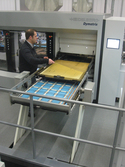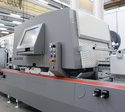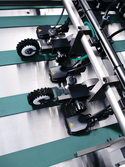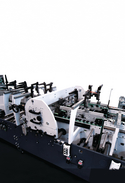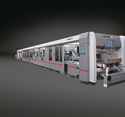A new generation of converting technology
5 April 2012In today’s burgeoning market for printed packaging, where the requirements of brand owners for top quality presentation must meet a growing awareness of the need for environmental protection, the case for carton and corrugated products is driving manufacturers to develop a new generation of converting technology. Nick Coombes looks at the trends in the market
According to Paul Thompson, packaging conversion specialist at Heidelberg UK: “Functionality and recyclability make carton and corrugated products the ideal carriers for today’s trade and retail customers. They offer the flexibility in style, texture, and appearance that brand owners demand, which makes it incumbent on the machinery manufacturers to develop and supply technology that is reliable, productive and adaptable.”
He was speaking ahead of the company’s Drupa launch of the Varimatrix 82CS diecutter for B2 work. Essentially a scaled down version of the successful 105CS model, the new smaller machine is intended to complement Heidelberg’s Speedmaster XL 75 offset press, and is a sign of the German manufacturer’s increasing commitment to the print for packaging market.
Folder gluers
Also at Drupa will be Heidelberg’s popular Diana X folder-gluer. Shown working with a packer, stack turner, and prefeeder, the modularity of the Diana makes it easy to configure for a variety of work as demand changes. New for Drupa will be the Braille module working with an inspection control system to ensure compliance with the latest EU legislation on package identification for the partially sighted. Falconer Print & Packaging has recently installed the first Diana X in the UK to be fitted with the Braille module, and claims to be seeing significant cost reductions.
Pinar Kucukaras, marketing manager at Duran Machinery, which manufactures the Omega range of folder-gluers, took up the debate, commenting: “Productivity, versatility, and reliability are no longer enough on their own – they are all taken as the norm. What we try to do is encourage our customers to think outside the box.”
The company says the noticeable trend in recent times is the changing structural design of the carton and this is challenging converters with their standard machines. This can prove a limiting factor in the growth and development of a business, so Duran Machinery takes a different approach. “Instead of forcing standard machines to run new designs, we manufacture a folder-gluer that can handle these new cartons, but allows the converter to run standard work, when necessary.” Explaining that this often involves three design offices: the machine manufacturer; the converter; and the customer, she insisted: ”Designers do not need to limit their imagination by existing machine capabilities.”
Founded in 1989, Duran Machinery manufactures folder-gluers to meet the specific production requirements. Its range includes the popular Omega Allpro in seven sizes ranging from 55 to 165cm, the sophisticated Omega Allpro S in five sizes from 90 to 165cm, the affordable Omega Performa in five sizes from 60 to 145cm, and the Omega Magnus 170–200–230cm speciality folder-gluer for corrugated packaging.
Research and development
R&D plays a major role at the machinery manufacturer in providing its customers with the latest technology to meet constantly changing market demands. In the carton and corrugated market, none feels this pressure more than the Bobst Group, where the mantra ‘innovation, productivity, and sustainability’ is applied across all production sectors, namely Bobst, Martin, and Asitrade.
The recent focus of Bobst Group innovation has been on inline processes for folding carton manufacture, in particular on ways to achieve ‘zero fault’ packaging production. One result of this is Accucheck, a system which, when integrated into a folder-gluer, checks the print on every carton run down the line – the first such system available for folder-gluers.
Accucheck detects a range of print and print-related defects such as hickeys and spots, physical defects of the carton such as scratches or rubs, inaccurate diecutting, and problems with the control of colour variation. Depending on the settings defined for the run, defective cartons can be allowed to continue or be automatically ejected, all without affecting production speed. Whether ejected or not, defects are recorded for later analysis.
Still in the arena of folder-gluers, Bobst recently launched Gyrobox, the first device for the corrugated board industry which can turn a blank through 90 degrees to fold and glue all four sides in just one pass. Available for some time to carton converters, Gyrobox now allows corrugated box makers to push their creativity, productivity and efficiency by reducing the complexity involved in producing the variety of boxes demanded by brand owners.
Diecutting
In the diecutting market, for those looking outside the Bobst and Heidelberg stables, Spanish-based Iberica, part of the Cerutti Group, has high hopes for a successful Drupa, with its three different ranges of flat bed machines. The Optima series, launched at Drupa 2008, is the introductory model but with the capability and strength to handle a variety of materials from carton and corrugated board to plastics. Easy to set up and run, the Optima is “an operator’s machine”, according to Iberica.
The Speed Series is the company’s high-tech platen, now available with the new Print Mark register system for the front and side-lays, and a full logistics system to remove manual loading and unloading. The 144 Series (SR and SRK) are the latest large format versions, with a cutting pressure of 600 tonnes to cope with a range of materials. At Drupa, Iberica will feature a Speed 105, and Speed K105 (with blanking) along with a new chase locking system, automatic window closure, and automatic chain tensioning.
High-end packaging
With demand for added-value packaging continuing to rise, as brand owners seek to increase the shelf appeal of their products, new means of decoration are being developed. It was this demand that led Bobst to develop the Masterfoil 106 PR high-end foil stamping press. The first machine was installed at Köch & Glasder in Germany, and has been an instant success, according to Thomas Glasder, managing partner of the company. “In addition to the high production speed of 8,000 sheets per hour, I was impressed by the interplay between the dynamic Power Register II system and the Smart Feeder system,” he commented, adding: “the Masterfoil 106 PR has brought precision and reliability of a previously unknown level.”
Moving on to corrugated, and the demand for high-end packaging, Asitrade’s latest litho-lam machine, the Masterflute, features a progressive sheet alignment system called Power Aligner which, without front stop and mechanical side-lays, senses the edges of incoming sheets with optical sensors, eliminating mechanical stops and the risk of sheet damage. This allows it to deliver the consistent overlap that is needed for accurate diecutting downstream. The company is also claiming that the new design takes into account increased noise limitations as well as the need for low energy consumption.
Corrugated
The Martin range of flexo folder-gluers (FFG) focuses on the ability to carry out full diecutting and deliver high quality graphics at high speeds. The extra-large diameter of the rotary diecutter on the Martin machines allows production of almost any die-cut box, from simple RSC’s with handles or holes, through those with asymmetrical creasing lines, to automatic crashlock bottom boxes and even bag-in-box styles. As with its DRO High Graphics range, Martin offers the same technology in its FFG NT platform. The company claims its NT technology makes printing on coated paper, with UV or IR varnishes, using a large scope of fluting, and then diecutting and folding inline, an ideal process for producing cost-efficient packaging. Other benefits from this totally integrated process are: a simplified supply chain; savings on waste and energy; and a much faster time-to-market.
In the market for corrugated diecutting, the basic question is ‘flat bed or rotary’, and there is plenty of choice for either technique. Which is best, can often be determined by the type and volume of work to be undertaken. Rotary is better suited to larger formats and longer runs, while flat bed shines on the more complex multi-up designs, usually produced in shorter runs.
Rotary technology
In the rotary sector, Martin claims to have more than 400 of its DRO lines installed. The range includes the DRO 1628 GT, a highly flexible and fast to make ready design, capable of producing 11,000 boxes an hour and ideal for shorter run work, and the DRO 1624-28-32 NT line, which is a high performance machine with servodrive designed for high graphics applications.
The latest development from Martin is the HBL (High Board Line) model, which can convert all boards from microflute to double-wall, and has an automated anilox change system for added flexibility and high quality print.
Mehr Maschine, (Göpfert Maschinen) manufactures the Evolution series in various forms. Promoted as tough and reliable, the Evolution features direct drive that combines accuracy and performance to give high productivity, together with touchscreen control. The latest drive technology allows for pre-programming of machine functions and results in fewer components and increased reliability, with remote diagnostics and service capability.
Emba Machinery manufactures a range of rotary diecutters with B&R drive technology, all based on a modular design principle that allows customers to re-configure the line at a later date to meet changing market demands.
Elsewhere, the rising tide of Asian manufacturers dominates the market. They include: Isowa, whose new FD 71 has been well received; TCY (Tien Chin Yu), which manufactures a range of servo controlled rotary diecutters; Latitude Machinery, which claims to have more than 200 of its flexo rotary diecutters installed; Shanghai SRPack machinery, whose Innova model range majors on high speed production, with fast makeready capability; and Dong Fang Carton Machinery, which claims to have combined the best of western and eastern technology to produce a range of competitively priced machines.
Flat bed technology
In the flat bed sector, Bobst, with its Expertcut, Visioncut, and Mastercut series, and Heidelberg with its Dymatrix and Varimatrix lines are well known and publicised. Other suppliers to this sector are: Asahi Machinery, which has just launched its ‘Lap Feeder’ vacuum system for improved sheet positioning to within ±3mm; Young Shin Europe, with its automatic YT range; UK-based newcomer Loadpoint, which brings 20 years of packaging industry experience to the market; Diecut UK, which offers flat bed machines and hand platens; Andrew & Suter, whose AS range is produced by Mirae PCM in South Korea; and Crosland, which offers the CompactCut for short and medium run work and single-person operation.
If the plethora of technology available is all too much to take in on paper, the upcoming Drupa 2012 will provide all the manufacturers with a perfect showcase to attract the attention of carton and corrugated converters from around the world. Don’t miss it!
Bobst’s Gyrobox CB Gyrobox CB Bobst’s Accucheck detects a range of print and print-related defects Accucheck Braille module on Heidelberg’s Diana Braille Heidelberg Dymatrix 106 chase Dymatrix Varimatrix 105 sheet feed Varimatrix Iberica Speed 105 Speed 105 Iberica Speed K 105 Speed K 105 Martin's NT technology is “ideal for cost-efficient packaging production" Martin's NT External weblinksConverting Today is not responsible for the content of external internet sites.Bobst Duran Emba Goepfert Heidelberg Iberica
